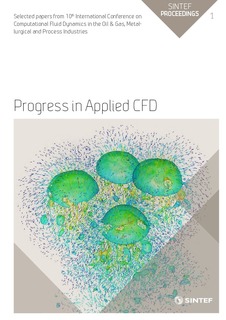| dc.contributor.author | Oshinowo, Lanre | |
| dc.contributor.author | Elsaadawy, Ehab | |
| dc.contributor.author | Vilagines, Regis | |
| dc.date.accessioned | 2017-11-08T08:32:53Z | |
| dc.date.available | 2017-11-08T08:32:53Z | |
| dc.date.issued | 2015 | |
| dc.identifier.isbn | 978-82-536-1432-8 | |
| dc.identifier.isbn | 978-82-536-1433-5 | |
| dc.identifier.issn | 2387-4295 | |
| dc.identifier.uri | http://hdl.handle.net/11250/2464800 | |
| dc.description.abstract | Variations in oil properties or water content influence the rate of crude oil-water separation. This presents a challenge for separator operations when conditions change as fields mature, and for the design of new internals to improve separation efficiency. Computational fluid dynamics (CFD) is being used to predict separator vessel hydrodynamics and previous studies of three-phase separators have characterized the dispersed phase with a single droplet size and constant phase properties. Modelling the evolving droplet size during separation is a critical requirement to developing a realistic separator model. Emulsion rheology is also an important phenomena typically overlooked in modeling oil-water separation. In this study, a transient Eulerian multiphase approach coupled with the population balance is used to predict the gas, oil and water separation behavior in three-phase horizontal gas-oil-water gravity separators. Here, the secondary water phase is divided into multiple velocity groups and a number of bins describe the droplet distribution within each velocity group. By considering the dispersed phase fraction in the water-in-oil emulsion rheology and incorporating this into the interphase interaction, a high viscosity emulsion is formed at the interface between the oil and water phases, known as the dense packed layer or zone (DPZ). The resulting DPZ is known to have an effect on oil-water separation efficiency. Experimental data was obtained from a high-pressure pilot scale three-phase separator rig and includes phase flow rates into and out of the vessel and vertical water fraction profiles at two locations in the separator. The data was compared to the CFD predictions of separation efficiency, phase distribution and DPZ thickness in the separator. | |
| dc.description.sponsorship | ACKNOWLEDGEMENTS. The authors acknowledge the Saudi Arabian Oil Company (Saudi Aramco) for supporting and granting permission to present and publish this article. The authors also acknowledge IFPEN for conducting the experiments and to TOTAL for their role in coordinating the experimental program. The authors would also like to acknowledge ANSYS for their support on the PID controller user-defined function and Scheme file. | |
| dc.language.iso | eng | |
| dc.publisher | SINTEF Academic Press | |
| dc.relation.ispartof | Selected papers from 10th International Conference on Computational Fluid Dynamics in the Oil & Gas, Metallurgical and Process Industries | |
| dc.relation.ispartofseries | SINTEF Proceedings;1 | |
| dc.subject | Emulsion | |
| dc.subject | Gravity separation | |
| dc.subject | Three-phase | |
| dc.subject | Separator | |
| dc.subject | Oil | |
| dc.subject | Multiphase | |
| dc.subject | Population balance | |
| dc.subject | CFD | |
| dc.title | CFD modeling of oil-water separation efficiency in three-phase separators | |
| dc.type | Chapter | |
| dc.type | Conference object | |
| dc.type | Peer reviewed | |
| dc.description.version | publishedVersion | |
| dc.rights.holder | © 2015 SINTEF Academic Press | |
| dc.subject.nsi | VDP::Technology: 500 | |
